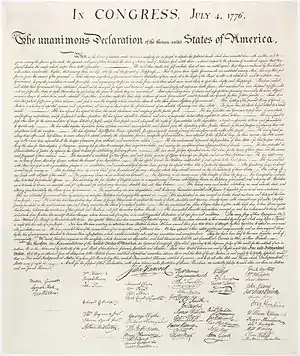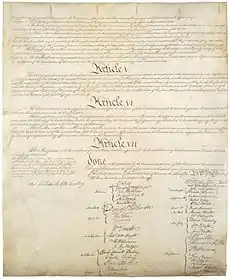Roger Sherman
Roger Sherman (April 19, 1721 – July 23, 1793) was an early American statesman and lawyer, as well as a Founding Father of the United States. He is the only person to have signed all four great state papers of the United States: the Continental Association, the Declaration of Independence, the Articles of Confederation, and the Constitution.[1]
Roger Sherman | |
|---|---|
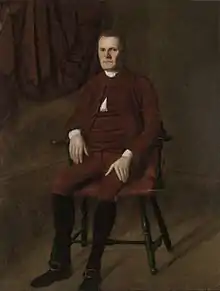 | |
| United States Senator from Connecticut | |
| In office June 13, 1791 – July 23, 1793 | |
| Preceded by | William S. Johnson |
| Succeeded by | Stephen M. Mitchell |
| Member of the U.S. House of Representatives from Connecticut's at-large district | |
| In office March 4, 1789 – March 3, 1791 | |
| Preceded by | None |
| Succeeded by | Amasa Learned |
| Delegate to the Continental Congress from Connecticut | |
| In office 1774–1781 | |
| In office 1784–1784 | |
| 1st Mayor of New Haven, Connecticut | |
| In office 1784–1793 | |
| Preceded by | Position established |
| Succeeded by | Samuel Bishop |
| Personal details | |
| Born | April 19, 1721 Newton, Province of Massachusetts |
| Died | July 23, 1793 (aged 72) New Haven, Connecticut, U.S. |
| Resting place | Grove Street Cemetery New Haven |
| Nationality | American |
| Political party | Pro-Administration |
| Spouse(s) | Elizabeth Hartwell Rebecca Minot Prescott |
| Profession | Politician, Lawyer |
| Signature | |
Born in Newton, Massachusetts, Sherman established a legal career in Litchfield County, Connecticut despite a lack of formal education. After a period in the Connecticut House of Representatives, he served as a Justice of the Superior Court of Connecticut from 1766 to 1789. He represented Connecticut at the Continental Congress and signed the Continental Association, which provided for a boycott against Britain following the imposition of the Intolerable Acts. He was also a member of the Committee of Five that drafted the Declaration of Independence. He later signed both the Articles of Confederation and the United States Constitution. In 1784, he was elected as the first mayor of New Haven, Connecticut.
Sherman served as a delegate to the 1787 Philadelphia Convention, which produced the United States Constitution. After Benjamin Franklin, he was the oldest delegate present at the convention. He favored granting the federal government power to raise revenue and regulate commerce, but initially opposed efforts to supplant the Articles of Confederation with a new constitution. He ultimately came to support the establishment of a new constitution, and proposed the Connecticut Compromise, which won the approval of both the larger states and the smaller states.[2]
After the ratification of the Constitution, Sherman represented Connecticut in the United States House of Representatives from 1789 to 1791. He served in the United States Senate from 1791 to his death in 1793.
Early life
Sherman was born into a family of farmers in Newton, Massachusetts, near Boston. His father was William and mother Mehetabel Sherman. The Shermans left Newton and settled in what became the township of Stoughton, 17 miles (27 km) south of Boston, when Roger was two.
Sherman's education did not extend beyond his father's library and grammar school, and his early career was spent as a shoemaker. However, he had an aptitude for learning, access to a good library owned by his father, and a Harvard-educated parish minister, Rev. Samuel Dunbar, who took him under his wing.
In 1743, his father's death made Sherman move with his mother and siblings to New Milford, Connecticut, where in partnership with his brother William, he opened the town's first store. He very quickly introduced himself in civil and religious affairs, rapidly becoming one of the town's leading citizens and eventually town clerk of New Milford. Due to his mathematical skill he became county surveyor of New Haven County in 1745, and began providing astronomical calculations for almanacs in 1759.
Marriages and family
Roger Sherman was married two times and had a total of fifteen children with thirteen reaching adulthood.
Sherman married Elizabeth Hartwell (born August 31, 1726 in Stoughton, Massachusetts) on November 17, 1749.[3] Elizabeth died on October 19, 1760.[4]
Sherman married Rebecca (also spelled Rebekah) Prescott (born on May 20, 1742, in Danvers, Massachusetts) on May 12, 1763 and had eight children: Rebecca, Elizabeth, Roger, Mehetabel (1st), Mehetabel (2nd), Oliver, Martha and Sarah.[5]
Legal, political career
%252C_by_John_Trumbull.jpg.webp)
Sherman is especially notable in United States history for being the only person to sign all four great state papers of the United States, the Articles of Association, the United States Declaration of Independence, the Articles of Confederation, and the United States Constitution. Robert Morris, who did not sign the Articles of Association, signed the other three. John Dickinson also signed three, the Continental Association, the Articles of Confederation and the United States Constitution. He was involved with the Declaration of Independence but abstained, hoping for a reconciliation with Britain.
Despite the fact that Sherman had no formal legal training, he was urged to read for the bar exam by a local lawyer and was admitted to the Bar of Litchfield, Connecticut in 1754, during which he wrote A Caveat Against Injustice[6] and was chosen to represent New Milford in the Connecticut House of Representatives from 1755 to 1758 and from 1760 to 1761.
Sherman was appointed justice of the peace in 1762 and judge of the court of common pleas in 1765. During 1766, Sherman was first elected to the Governor's Council of the Connecticut General Assembly, where he served until 1785.
Sherman served as Justice of the Superior Court of Connecticut from 1766 to 1789, when he left to become a member of the United States Congress.
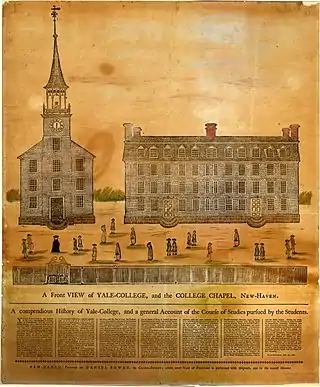
Sherman was also appointed treasurer of Yale College, and awarded an honorary Master of Arts degree. He was a professor of religion for many years, and engaged in lengthy correspondences with some of the theologians of the time.
During February 1776, Sherman, George Wythe, and John Adams were members of a committee responsible for establishing guidelines for U.S. embassy officials in Canada with the committee instructions that included, "You are to declare that we hold sacred the rights of conscience, and may promise to the whole people, solemnly in our name, the free and undisturbed exercise of their religion. And ... that all civil rights and the rights to hold office were to be extended to persons of any Christian denomination."
In 1784 he was elected Mayor of New Haven, which office he held until his death.
In 1790 both Sherman and Richard Law were appointed to revise the confused and archaic Connecticut statutes, which they accomplished.
Throughout his life, Sherman was a major benefactor of Yale College, acting as the university's treasurer for many years and promoting construction of a college chapel. Roger Sherman died in 1793.
Constitutional Convention
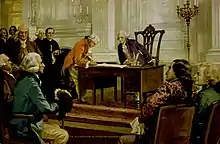
Roger Sherman was one of the most influential members of the Constitutional Convention. He is not well known for his actions at the Convention because he was a "terse, ineloquent speaker" who never kept a personal record of his experience, unlike other prominent figures at the convention such as James Madison, and at 66 years of age, Sherman was the second eldest member at the convention following Benjamin Franklin (who was 81 years old at the time). Yet as one of the most active members of the Convention, Sherman made motions or seconds in reference to the Virginia Plan 160 times.[8] His opponent Madison made motions or seconds 177 times.[8]
Roger Sherman came into the Convention without the intention of creating a new constitution. Sherman, an original signer of the Articles of Confederation, saw the convention as a means to modify the already existing government. Part of his stance was concerned with the public appeal. He defended amending the articles declaring that it was in the best interest of the people and the most probable way the people would accept changes to a constitution.[9] Sherman saw no reason for a bicameral legislature, as proposed by the Virginia Plan. "The problem with the old government was not that it had acted foolishly or threatened anybody's liberties, but that it had simply been unable to enforce its decrees".[2] Sherman further advanced the idea that the national government simply needed a way to raise revenue and regulate commerce.[2] Sherman was a big defender of a unicameral legislature. He defended the unicameral legislature of the Articles of Confederation by stating that the large states had not "suffered at the hands of small states on account of the rule of equal voting".[2] Ultimately, when Sherman saw his initial goals of the convention as unattainable he organized compromises and deals in order to enact some of his desirable legislation.
Sherman was from a particularly isolationist state – Connecticut operated almost without much need from other states, using its own ports[10][11][12][13] to trade with the West Indies[14][15] instead of utilizing ports in Boston –[9] and feared that "...the mass of people lacked sufficient wisdom to govern themselves and thus wished no branch of the federal government to be elected directly by the people".[16][17] Sherman, Elbridge Gerry (himself later recognized as the namesake of American political gerrymandering) and others were of the shared opinion that the elected composition of the national government should be reserved for the vote of state officials and not for election by the will of the people. Sherman was wary of allowing ordinary citizen participation in national government and stated that the people "should have as little to do as may be about the Government. They want information and are constantly liable to be misled".[18]
The two proposed options for the formation of the legislative branch emerged in the deliberations. One was to form a bicameral legislature in which both chambers had representation proportional to the population of the states, which was supported by the Virginia plan. The second was to modify the unicameral legislature that had equal representation from all of the states, which was supported by the New Jersey plan. Roger Sherman was a devout supporter of a unicameral legislature, but when he saw that goal as unattainable he motioned to compromise. In terms of modes of election "Sherman moved to allow each state legislature to elect its own senators".[18] Additionally, in the house Sherman originally proposed that the suffrage of the House of Representatives should be figured according to the "numbers of free inhabitants" in each state.[2]
In this plan, designed to be acceptable to both large and small states, the people would be represented proportionally in one branch of the legislature, called the House of Representatives (the lower legislative house). The states would be represented in another house called the Senate (the upper house). In the lower house, each state had a representative for every one delegate. In the upper house, each state was guaranteed two senators, regardless of its size.
Sherman is also memorable for his stance against paper money with his authoring of Article I, Section 10 of the United States Constitution and his later opposition to James Madison over the "Bill of Rights" amendments to the U.S. Constitution in his belief that these amendments would diminish the role and power of the states over the people.[19]
Mr. Wilson & Mr. Sherman moved to insert after the words "coin money" the words "nor emit bills of credit, nor make any thing but gold & silver coin a tender in payment of debts" making these prohibitions absolute, instead of making the measures allowable (as in the XIII art) with the consent of the Legislature of the U.S. ... Mr. Sherman thought this a favorable crisis for crushing paper money. If the consent of the Legislature could authorize emissions of it, the friends of paper money would make every exertion to get into the Legislature in order to license it."[20]
In terms of the executive Sherman had very little interest in giving the executive much authority. Sherman suggested that no constitutional provision needed be made for the executive because it was "nothing more than an institution for carrying the will of the Legislature into effect".[18]
Originally opposed to slavery due to his personal beliefs and puritan views, Sherman used the issue of slavery as a tool for negotiation and alliance. Sherman was of the opinion that slavery was already gradually being abolished and the trend was moving southward.[18] Sherman saw that the issue of slavery could be one that threatened the success of the constitutional convention. Therefore, Sherman decided to help pass legislation to benefit slave states in order to obtain unlikely allies from South Carolina. The two forces joined together because they both, due to the economies of their home states, benefitted from there being no export tax.[2]
Sherman opposed appointment of fellow signer Gouverneur Morris as minister to France because he considered that high-living Patriot to be of an "irreligious nature".[21]
Quotation
In a letter to Oliver Wolcott (May 21, 1777) he wrote, "I think it dangerous to admit citizens not connected to the army to be tried by a Court Martial".[22]
Death and burial site
Sherman died in his sleep on July 23, 1793, after a two-month illness diagnosed as typhoid fever.[23] The Gazette of the United States (Philadelphia, Pennsylvania), August 17, 1793, p. 508, reported an alternate diagnosis, "He was taken ill about the middle of May last, and from that time declined till his death. His physician supposed his disorder to be seated in his liver."
He was buried in New Haven Green. In 1821, when that cemetery was relocated, his remains were moved to the Grove Street Cemetery.[24]
Legacy

The town of Sherman, Connecticut was named for Roger Sherman.[25]
See also
- List of United States Congress members who died in office (1790–1899)
- U.S. Constitution, floor leader in Convention.
References
- Specific
- "Roger Sherman". Architect of the Capitol. Retrieved 2019-08-13.
- Collier, Christopher, and James Lincoln Collier. Decision in Philadelphia: The Constitutional Convention of 1787. New York: Random House, 1986. Print.
- "A Biography of Roger Sherman (1721-1793)". let.rug.nl. Retrieved 2019-08-13.
- Sherman genealogy, including families of Essex, Suffolk and Norfolk, England, p. 150; published 1920, author Sherman, Thomas Townsend (born 1853). Retrieved 2016-05-17.
- Sherman, Thomas Townsend (1920). Sherman genealogy, including families of Essex, Suffolk and Norfolk, England. University of California Libraries. New York : T.A. Wright. pp. 153–154.
- Sherman, Roger A Caveat Against Injustice
- Robinson, Raymond H. (1999). "The Marketing of an Icon". George Washington: American Symbol. p. 117. ISBN 9781555951481.
Figure 56 John Henry Hintermeister (American 1869-1945) Signing of the Constitution, 1925...Alternatively labeled Title to Freedom and the Foundation of American Government...".
- Robertson, David B. "Madison's Opponents and Constitutional Design." The American Political Science Review 99.22 (2005): 225–243. JSTOR. Web. February 11, 2015.
- Boyd, Julian P. "Roger Sherman: Portrait of a Cordwainer Statesman." The New England Quarterly 5.2 (1932): 221–236. JSTOR. Web. February 12, 2015.
- "A Vanished Port: Middletown & the Caribbean, 1750-1824". Middlesex County Historical Society. 2016-08-07. Retrieved 2019-08-13./
- Cedrone, Sarajane (2017-03-01). "Connecticut in the Golden Age of Smuggling". Connecticut Explored. Retrieved 2019-08-13.
- "Vanished Port: Middletown and the Great Era of West Indies Trade". Wesleyan University Magazine. 2011-01-15. Retrieved 2019-08-13.
- "Discovering Connecticut's Old Port Cities". The New York Times. 1981-10-09. Retrieved 2019-08-13.
- Shapiro, Deborah (2016-09-22). ""Vanished Port" Exhibit Introduces Speakers' Series". courant.com. Retrieved 2019-08-13.
- Federal Writers' Project (2013-10-31). The WPA Guide to Connecticut: The Constitution State. Trinity University Press. p. 79. ISBN 978-1-59534-206-5.
- Cincotta, Howard (1994). "Ch 4: The Formation of a National Government". An Outline of American History. United States Information Agency.
- Foote, George; Silocka, Richard (2018). "New Haven: Maritime History and Arts". Yale-New Haven Teachers Institute. Retrieved 2019-08-13.
- Rakove, Jack N. Original Meanings: Politics and Ideas in the Making of the Constitution. New York: A.A. Knopf, 1996. Print.
- "sherman". Rutgers University History Department. Retrieved 2019-08-13.
- Farrand, Max, ed. The Records of the Federal Convention of 1787.
- "Roger Sherman". U.S. Army Center of Military History. Retrieved 2019-08-13.
- Sherman genealogy, including families of Essex, Suffolk and Norfolk, England, p. 187; published 1920, author Sherman, Thomas Townsend (born 1853). Retrieved 2016-05-17.
- Rommel, John G. (1979). Connecticut's Yankee patriot, Roger Sherman. Connecticut bicentennial series. 34. American Revolution Bicentennial Commission of Connecticut. p. 53. ISBN 978-0-918676-20-7. OCLC 651919763.
- Boardman (1938). Signer and Statesman. University of Pennsylvania Press. p. 336.
- The Connecticut Magazine: An Illustrated Monthly. Connecticut Magazine Company. 1903. p. 334.
- General
- Dictionary of American Biography
- Boardman, Roger Sherman, Roger Sherman, Signer and Statesman, 1938. Reprint. New York: Da Capo Press, 1971.
- Boutell, Lewis Henry, The Life of Roger Sherman, Chicago: A.C. McClurg & Co., 1896.
- Hall, Mark David, Roger Sherman and the Creation of the American Republic (New York: Oxford University Press, 2013)
- Gerber, Scott D., "Roger Sherman and the Bill of Rights." Polity 28 (Summer 1996): 521–540.
- Hoar, George Frisbie, The Connecticut Compromise. Roger Sherman, the Author of the Plan of Equal Representation of the States in the Senate, and Representation of the People in Proportion to Numbers in the House, Worcester, MA: Press of C. Hamilton, 1903.
- Rommel, John G. (1979). Connecticut's Yankee patriot, Roger Sherman. Connecticut bicentennial series. 34. American Revolution Bicentennial Commission of Connecticut. ISBN 978-0-918676-20-7. OCLC 651919763.
External links
- From Rev. Charles A. Goodrich, Lives of the Signers to the Declaration of Independence, 1856
- United States Congress. "Roger Sherman (id: S000349)". Biographical Directory of the United States Congress.
- Sherman, Thomas Townsend (1920). Sherman Genealogy Including Families of Essex, Suffolk and Norfolk, England. T. A. Wright. p. 345.
- Baldwin-Greene-Gager family of Connecticut at Political Graveyard
- Sherman-Hoar family at Political Graveyard
- Roger Sherman Papers Yale University
- Roger Sherman, Revolutionary and Dedicated Public Servant Connecticut History
- History of Sherman's boyhood home of Stoughton, Massachusetts
- Chisholm, Hugh, ed. (1911). . Encyclopædia Britannica (11th ed.). Cambridge University Press.
| Political offices | ||
|---|---|---|
| Preceded by None |
Mayor of New Haven, Connecticut 1784–1793 |
Succeeded by Elizur Goodrich |
| U.S. Senate | ||
| Preceded by William S. Johnson |
U.S. senator (Class 3) from Connecticut 1791–1793 Served alongside: Oliver Ellsworth |
Succeeded by Stephen M. Mitchell |
| U.S. House of Representatives | ||
| Preceded by District created |
Member of the U.S. House of Representatives from Connecticut's at-large congressional district 1789–1791 |
Succeeded by Amasa Learned |
| Honorary titles | ||
| Preceded by William S. Johnson |
Oldest living U.S. Senator June 13, 1791 – July 23, 1793 |
Succeeded by William S. Johnson |
